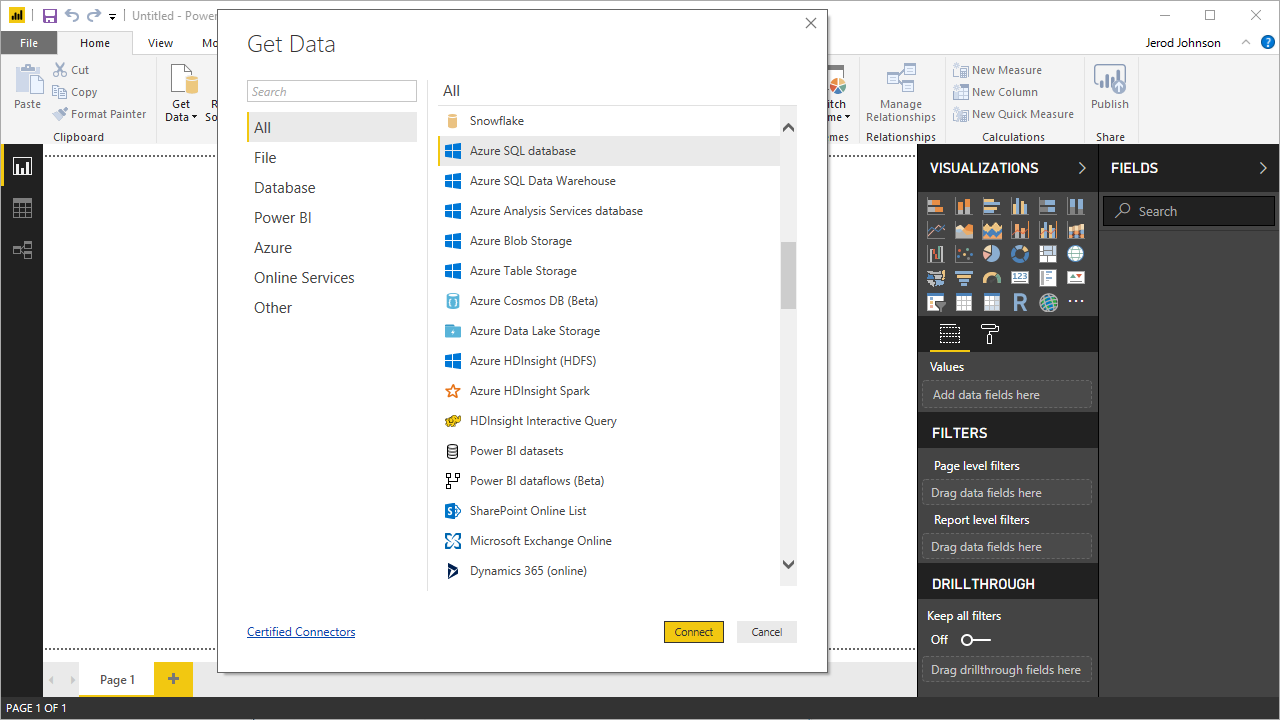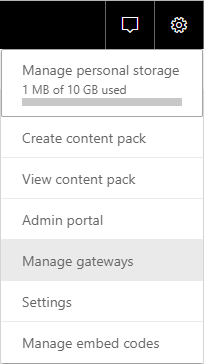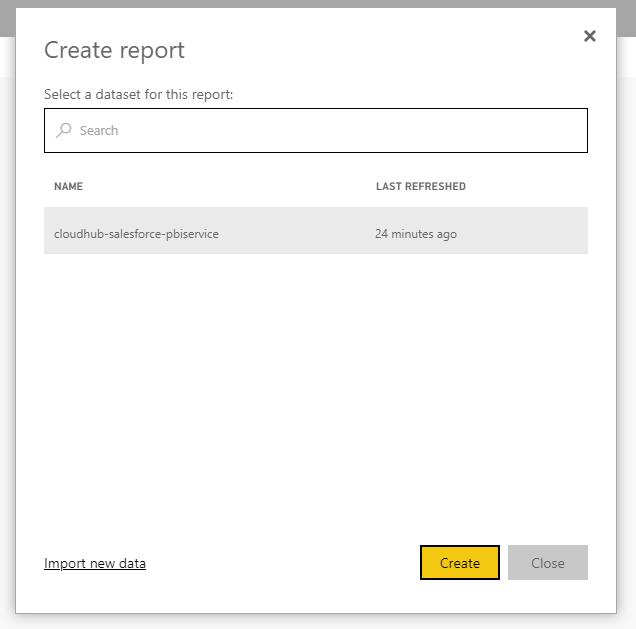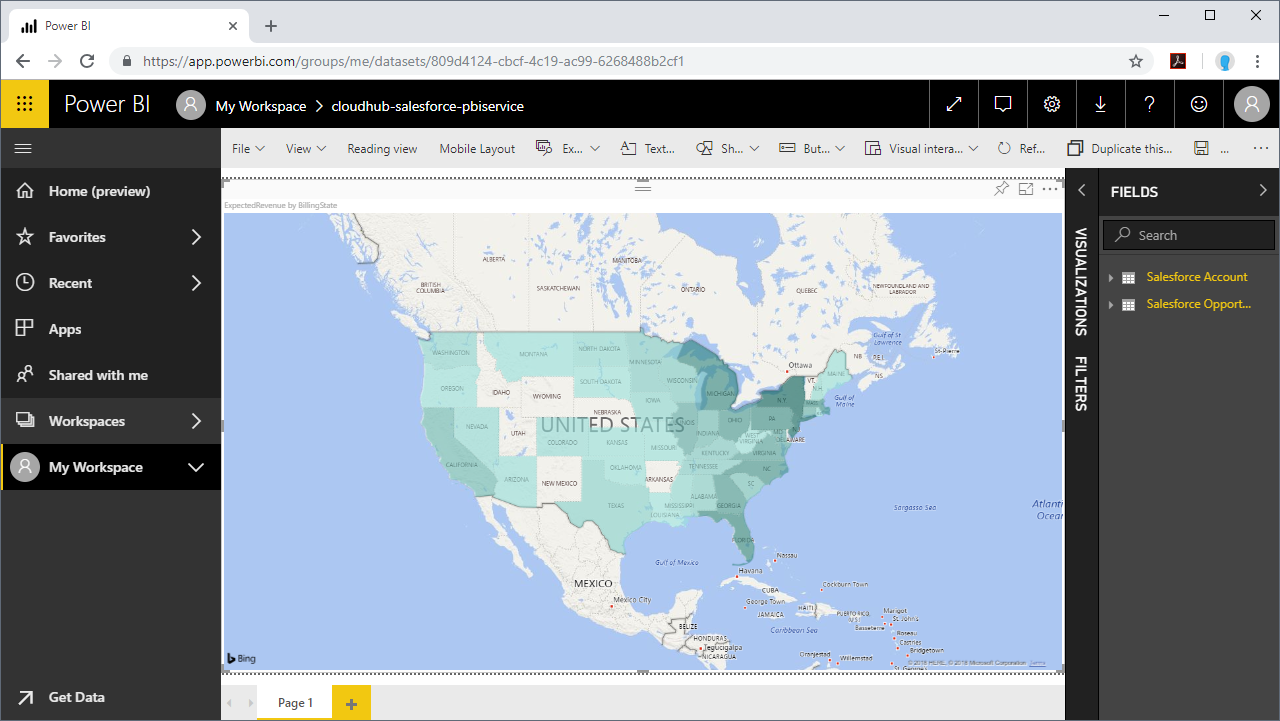Discover how a bimodal integration strategy can address the major data management challenges facing your organization today.
Get the Report →Visualize Live SAS Data Sets Data in the Power BI Service
Use CData Connect Server to create a virtual SQL Server database for SAS Data Sets data and create custom reports in the Power BI Service.
Power BI transforms your company's data into rich visuals for you to collect and organize so you can focus on what matters to you. When paired with CData Connect Server, you get instant access to SAS Data Sets data for visualizations, dashboards, and more. This article shows how to build and publish a dataset from SAS Data Sets data in Power BI and then create reports on SAS Data Sets data in the Power BI service.
CData Connect Server provides a pure SQL interface for SAS Data Sets, allowing you to easily build reports from live SAS Data Sets data in Power BI — with no need to replicate the data. As you build visualizations, Power BI generates SQL queries to gather data. Using optimized data processing out of the box, CData Connect Server pushes all supported SQL operations (filters, JOINs, etc) directly to SAS Data Sets, leveraging server-side processing to quickly return SAS Data Sets data.
NOTE: You can also import SAS Data Sets data into Power BI through Connect Server (instead of using the on-premise gateway). Read how in the related Knowledge Base article.
Create a Virtual SQL Database for SAS Data Sets Data
CData Connect Server uses a straightforward, point-and-click interface to connect to data sources and generate APIs.
- Login to Connect Server and click Connections.
![Adding a connection]()
- Select "SAS Data Sets" from Available Data Sources.
-
Enter the necessary authentication properties to connect to SAS Data Sets.
Set the following connection properties to connect to your SAS DataSet files:
Connecting to Local Files
- Set the Connection Type to "Local." Local files support SELECT, INSERT, and DELETE commands.
- Set the URI to a folder containing SAS files, e.g. C:\PATH\TO\FOLDER\.
Connecting to Cloud-Hosted SAS DataSet Files
While the driver is capable of pulling data from SAS DataSet files hosted on a variety of cloud data stores, INSERT, UPDATE, and DELETE are not supported outside of local files in this driver.
Set the Connection Type to the service hosting your SAS DataSet files. A unique prefix at the beginning of the URI connection property is used to identify the cloud data store and the remainder of the path is a relative path to the desired folder (one table per file) or single file (a single table). For more information, refer to the Getting Started section of the Help documentation.
![Configuring a connection (SQL Server is shown).]()
- Click Save Changes
- Click Privileges -> Add and add the new user (or an existing user) with the appropriate permissions.
Connecting to Connect Server from Power BI
To connect to and visualize live SAS Data Sets data in the Power BI service), install the on-premises data gateway, add a data source to the gateway from the Power BI service, and publish a dataset from Power BI Desktop to the service.
Install the On-Premises Data Gateway
The Microsoft on-premises data gateway provides secure data transfer between connected data sources and various cloud-based Microsoft tools and platforms. You can read more about the gateway in the Microsoft documentation.
You can download and install the gateway from the Power BI service:
- Log in to PowerBI.com.
- Click the Download menu and click Data Gateway.
![Download the Data Gateway]()
- Follow the instructions for installation, making note of the name of the gateway.
Add SAS Data Sets as a Data Source to the Power BI Service
Once you have installed the data gateway, you add Connect Server as a data source to the Power BI service:
- Log in to PowerBI.com.
- Click the Settings menu and click "Manage gateways."
![Settings -> Manage gateways]()
- Click "ADD DATA SOURCE" and configure the connection to Connect Server:
- Set Data Source Name Connect_SASDataSets.
- Choose SQL Server as the Data Source Type.
- Set Server to the address of your Connect Server instance (i.e.: connect_server_url).
- Set Database to the name of your virtual SAS Data Sets database (i.e.: SASDataSets1).
- Set Authentication Method to Basic.
- Set Username and Password to Connect Server credentials.
Publish a Dataset from Power BI Desktop
With the gateway installed and Connect Server added as a datasource to the Power BI service, you can publish a dataset from Power BI Desktop to the service.
- Open Power BI, click Get Data -> More, then select SQL Server database, and click Connect.
- Set the connection properties and click OK.
- Set Server to the address of your Connect Server instance (i.e.: connect_server_url).
- Set Database to the name of your virtual SAS Data Sets database (i.e.: SASDataSets1).
- Set Data Connectivity mode to DirectQuery*.
![Connect to CData Connect Server instance]() * DirectQuery enables live query processing and real-time visualizations of SAS Data Sets data.
* DirectQuery enables live query processing and real-time visualizations of SAS Data Sets data.
- In the authentication wizard, select Database, set the User name and Password properties, and click Connect.
- Select the table(s) to visualize in the Navigator dialog.
In the Query Editor, you can customize your dataset by filtering, sorting, and summarizing SAS Data Sets columns. Click Edit to open the query editor. Right-click a row to filter the rows. Right-click a column header to perform actions like the following:
- Change column data types
- Remove a column
- Group by columns
Power BI detects each column's data type from the SAS Data Sets metadata reported by Connect Server.
Power BI records your modifications to the query in the Applied Steps section, adjusting the underlying data retrieval query that is executed to the remote SAS Data Sets data. When you click Close and Apply, Power BI executes the data retrieval query.
Otherwise, click Load to pull the data into Power BI.
- Define any relationships between the selected entities on the Relationships tab.
- Click Publish (from the Home menu) and select a Workspace.


Build Reports and Dashboards on SAS Data Sets Data in the Power BI Service
Now that you have published a dataset to the Power BI service, you can create new reports and dashboards based on the published data:
- Log in to PowerBI.com.
- Click Workspaces and select a workspace.
- Click Create and select Report.
- Select the published dataset for the report.
![Select a dataset]()
- Choose fields and visualizations to add to your report.
![Visualizing SAS Data Sets data in the Power BI service]()
SQL Access to SAS Data Sets Data from Cloud Applications
Now you have a direct connection to live SAS Data Sets data from the Power BI service. You can create more data sources and new visualizations, build reports, and more — all without replicating SAS Data Sets data.
To get SQL data access to 200+ SaaS, Big Data, and NoSQL sources directly from your cloud applications, see the CData Connect Server.










 * DirectQuery enables live query processing and real-time visualizations of SAS Data Sets data.
* DirectQuery enables live query processing and real-time visualizations of SAS Data Sets data.


